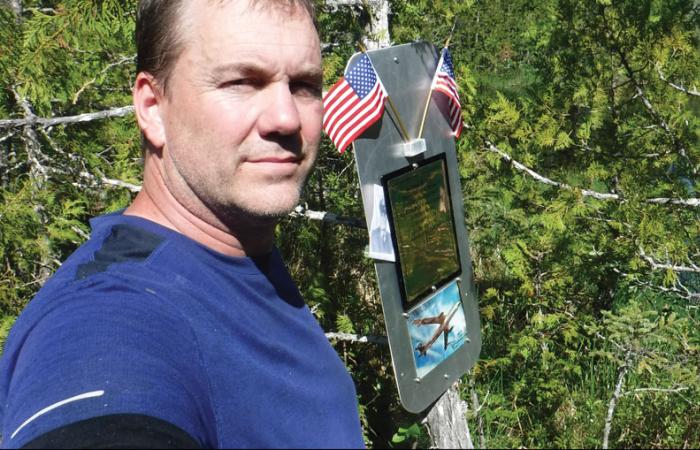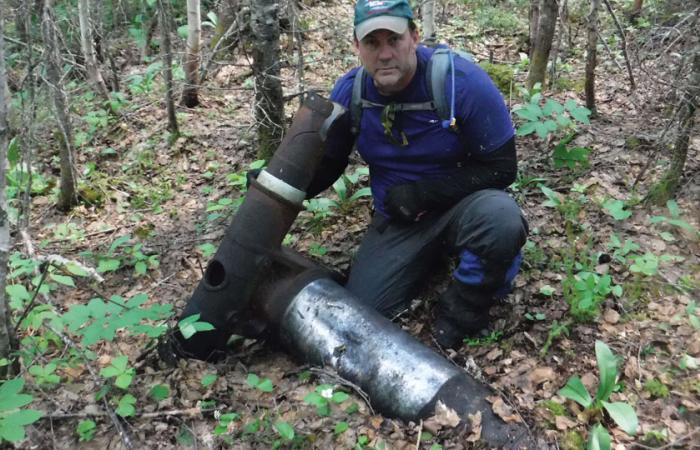When you’re searching for something, you never know how a little Bayview magazine can help.
For those of you who read the 2019 spring article, Rob Farrow: the Roads Less Travelled you’ll recall that one of this ATV/Motorbike explorer and adventure-man’s dreams was to find the crash site of a U.S. Airforce B47E Stratojet Bomber, that went down November 30, 1956, somewhere north of Thunder Bay. Farrow had been experiencing several challenges in finding the wreckage as information was sparse and it seemed as if nobody knew anyone who could lead him to the exact location.
Until his story was told in Bayview.
After reading the article, two men, who had been working at Great Lakes Paper Company Camp #1 during the time of the crash, contacted Farrow through his Facebook page and asked if they could meet. They told Farrow they were there the evening the plane crashed and exploded, and snowshoed to the site the morning after the crash.
Farrow learned that two loggers joined up with two O.P.P. officers and followed the sound of another American plane that was circling the site, until they found the wreckage. The rest of the information they relayed confirmed what Farrow had read in various articles: Major Robert Slane, the pilot, was the only survivor. The others, navigator Lt. Donald Petty, co-pilot Richard Martin, and fellow comrade Lt. Max Workman were never found. Blood tests confirmed that tissue samples and blood found at the site were those of Martin and Workman, but nothing at the site confirmed – or disproved – Petty’s death. It could only be speculated that Petty ejected from the plane before it crashed and he did not survive. The search party combed the area for nearly three days and nothing was found.
After the two loggers verified Farrow’s beliefs of where the plane had crashed, he returned to the area where he had last searched, confident he was on the right track. Unable to find anything that day he returned again and combed another area. When he found a piece of aluminum and then another a few metres away, he knew he was getting close. Further into the bush he found pieces of the plane including the rear landing gear, a rubber fuel bladder, a disintegrated cockpit, and two jet engines. He had finally found the plane.
When asked how it felt to find the wreckage, Farrow says, “I felt a sense of accomplishment, but the fact that this was a grave site for three young men made it definitely sombre.”
And finding the wreckage only added more to the mystery.
The plane did not have a black box so little is known about the last few moments of the flight. It can be speculated that two people did not eject from the plane as they found two unopened chutes near the wreckage. The fact that no blood from Petty was found near the wreckage and no sign of his body, either living or dead, was found during the 3-day search, adds only more questions.
Another interesting thing to note about this American plane was that it was the fastest bomber of its time. It was approximately 107 feet long with a wingspan of 118 feet and its 6-jet engine pushed it to fly easily at 608 miles/hour. A plane like this, returning from a mission in the Arctic, near to Soviet territory, could have, may have, been carrying a nuclear bomb. Of course, it’s all speculation, but it’s one more piece of the puzzle that’s still missing.
The B47E, however, had a 10% crash rate and engineers were not able to determine the cause of many malfunctions until after the crash in 1956 when Major Slane could shed some light on what had happened before the plane exploded. Because of this, changes were made to the other B47E’s and the crash rate decreased significantly.
When Farrow returned to Thunder Bay, he posted his findings on his Facebook page and immediately his followers were posting notes of “Congratulations”. Farrow also expressed his desire to leave a marker at the site, something that would recognize the men who had died there. A friend of Farrow’s, Dave Everett, from the UPS Store on Memorial, offered to create a plaque. The U.S. Airforce donated a photo of a plane much like the B47E, signed by Colonel Holstom, thanking the Great Lakes employees who helped with the search for the plane on that November day.
Farrow mounted the plaque and a copy of the photo, along with a couple of American flags, on a metal board, returned to the site and nailed it to a tree. “Everyone deserves a marker,” he said. “Especially if it’s a grave site.”
After posting a photo of the plaque on his Facebook page, Rob received a message from D. Scott Petty, nephew of Lt. Donald Petty. They had connected earlier and Farrow kept Petty informed as any discoveries were made. Scott wrote: “Thank you for reaching out today Rob. This indeed is most likely my uncle’s crash site. I understand this is extremely remote, so I appreciate your efforts to help honor him and his fallen comrades.”
At the end of a You Tube video Farrow recorded about the crash, he asks that if anyone visits the site that they do not remove anything and leave everything as is in respect for the young men who died there. As for any information from Farrow on how to get to the site he says, “It’s somewhere up north.”
And as Farrow solved this mystery, he can be assured that many good things have happened because of his restless desire to take the road less travelled. And like all adventurers, he knows there will be another one waiting for him, just around the corner.
Stay tuned for the next journey.





